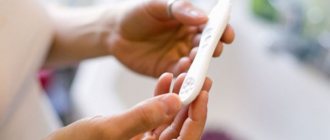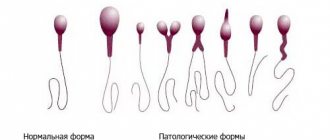What is hCG?
HCG is human chorionic gonadotropin, or, as it is also called, the “pregnancy hormone”. It is the main indicator of fertilization and the beginning of embryo development. Its production intensifies at the moment when the embryo, having passed through the fallopian tubes, begins to implant in the uterus. The chorionic villi fuse with the endometrium, this is how the exchange between the body of the mother and the baby begins, and with it changes in the woman’s hormonal background. HCG begins to rise already on the 6th day after the fusion of germ cells, and its concentration in the blood doubles every 48-72 hours in the first trimester. The level of this hormone is considered one of the most important indicators of the presence and proper development of pregnancy, and its deficiency is often the main symptom of ectopic implantation or arrested embryonic growth.
All tests react to hCG
Pregnancy tests are based on the diagnosis of beta-hCG, which has a special structure and is easier to “track” in urine. Chorionic gonadotropin appears in it approximately 1-2 weeks after fertilization, therefore, already on the first day of the delay, the simplest and most inexpensive pharmacy tests can determine the presence or absence of conception. More sensitive options allow analysis to be carried out 5-6 days before the expected date of the start of a new cycle.
Time of day: when to take a pregnancy test
Levels of the hCG hormone increase during pregnancy, so there are no rules about when to take the test: after all, the hormones are not going away. But in the early stages, the hCG level is too low to accurately check your situation. However, in the morning its concentration is much higher than in the afternoon or evening, so the test result at this time will be more accurate. And during the delay, a highly sensitive test will show an accurate result regardless of the time of day.
Early pregnancy symptoms: 5 first warning signs
However, for a more accurate result, the following factors must be taken into account:
- Urine should be fresh;
- Before checking your position, do not drink a lot of fluids or diuretics, as this will dilute the concentration of urine;
- Before the test, it is best to refrain from urinating for four hours.
It is best to take a pregnancy test on the first day of your delay. But here everything is individual, since if ovulation was early, then the study will show the result even before the expected start of menstruation. With late ovulation during the delay, you can see only one strip, regardless of the reliable result. Therefore, it is recommended to do another test in a few days.
If the dates of ovulation are unknown, then they can be found out online, through a special calculator, where the necessary data is entered in order to calculate the entire cycle.
How the tests work
The test has a “working” area - it can be a strip strip, an applicator for stream collection of urine, or a small window in the body where the biomaterial is transferred with a pipette. A special reagent is applied to the surface of such a zone. When it comes into contact with urine, it turns a bright color, and a control strip or similar indication appears on its surface. If the concentration of hCG in the urine exceeds the threshold sensitivity level of the test, a second strip appears on it. Even if it is very weak, but discernible, the result is positive. In electronic tests, intermediate stages are hidden from view, and the final result is displayed on the screen - as a rule, it corresponds not only to a positive or negative result, but also to an approximate period in weeks.
Features of the pregnancy test
Tests of any kind work on the same principle. They reflect the presence in the blood of a special hormone - human chorionic gonadotropin, or hCG for short. It begins to be produced in the blood the moment the egg is fertilized.
Its level actively increases already in the first days of egg fertilization. It reaches its maximum value by the eighth week. It is not recommended to use tests immediately after sexual intercourse, as they will not show positive results.
Also, in the first days after a missed period, the test may show the absence of pregnancy, since the hormone has not yet appeared in the urine. It begins to actively spread only on the tenth day after fertilization of the egg.
If you do not want to become a mother, then you should use contraception
Most product manufacturers promise the most accurate and reliable results, which in most cases is not confirmed. If you want to find out the news as quickly as possible, doctors advise donating blood for a hCG test. The hormone appears in it much faster than in urine.
Basic recommendations for using pregnancy tests
The procedure is very simple and does not require much of your time. To do this, you need to take a container with your urine. After this, the unpacked tester is lowered into the container to the level specified by the manufacturer. You need to wait a few seconds before the stripes appear.
There are also tests that allow you to use it while urinating, which is a more convenient option. However, do not forget that you can get the most accurate results only two weeks after the conception process.
The easiest to use pregnancy detection test - inkjet
Before carrying out the procedure, you should pay attention to the following features and recommendations:
- It is advisable to use urine collected in the morning for the procedure. However, if this is not possible, then you need to ensure that the urine is in the bladder for at least five hours before the procedure. Then the level of the hCG hormone will be higher.
- If you are taking certain medications, this may have a negative effect on your results. Therefore, before using the test, you should carefully study the instructions.
- It is not recommended to drink a lot of liquid before the procedure, as it will dilute the urine and reduce the concentration of the hCG hormone.
- There are times when the test does not work even if symptoms are present. Then it is recommended to contact an experienced specialist who will prescribe all the necessary tests for you.
Types of pregnancy tests
To understand how to use a pregnancy test correctly, you need to choose the appropriate type. Pharmacy models vary in shape, design, as well as cost and sensitivity. The simplest models give a positive reaction at a hCG level of 25-30 mIU/ml; the hormone reaches this concentration approximately 14-16 days after conception, that is, just in time for the expected start of the next menstruation and the first days of its delay. More sensitive tests can determine pregnancy at a hCG concentration of 20 mIU/ml, that is, they will help confirm conception 2-3 days before the expected menstruation or on the first day of the delay. Modern and expensive tests, usually electronic, recognize hCG already at 10-15 mIU/ml, that is, they can be used a week before the end of the cycle. This option is especially convenient for couples who were planning a pregnancy and know the exact date range when ovulation and conception occurred.
How do pregnancy tests work?
Can a pregnancy test be reused?
The possibility of multiple - up to 21 - pregnancy checks is provided only by electronic tests with replaceable cartridges. The remaining options are only suitable for one-time use.
How to care for reusable tests
The reusable electronic hCG test is a device that comes with 20 replaceable cartridges for reuse. This test has a USB connector on one side, which is inserted into a computer, onto which information is displayed in the form of a spectrogram about the test results. On the opposite side there is a hole where the cartridge is inserted. If the result is positive, the computer program allows you to calculate the approximate date of birth, if negative, the days of the next ovulation. Information about pregnancy or its absence is displayed simultaneously on the test itself in an electronic window.
A reusable electronic test costs around 1000 - 1200 rubles, so it is almost impossible to find it on the shelves of domestic pharmacies (but you can order it online)
To ensure more accurate results, you must follow the rules for caring for the device:
- throw away the cartridge after checking;
- monitor the integrity of the packaging of spare cartridges;
- do not allow liquid to spill past the replacement cartridge;
- after exhausting the number of checks (21), purchase a new reusable electronic pregnancy test.
I've only used strip strips and I'm completely tired of them. If I were faced with the need to frequently take a pregnancy test, I would buy reusable electronic ones. Despite the high price, they seem to me more profitable than disposable options.
Strip tests
The first “stripes” appeared in the early 80s. They have the simplest possible design - a cardboard base, a foam pad on the applicator that conducts urine to the working area on which the reagent is applied. When filled, the control zone changes color to bright pink-violet, a “check” strip is formed on it, indicating that the test is working, and after a few minutes a diagnostic result may appear in the form of a second strip.
Advantages : affordable price (within 100-150 rubles), simple operating principle.
Disadvantages : low sensitivity, the need to collect urine in a separate container, difficulties in interpreting the result due to the weak coloring of the second strip during early studies or changes in the control zone after the time of analysis specified by the manufacturer.
How to use : you need to collect a small amount of urine in a clean container, then you need to open the sealed bag with the strip test, immerse it with the applicator in the biomaterial to the indicated mark, hold for the required amount of time (usually 10 seconds). After this, the test is placed on a clean, dry horizontal surface. The result can be assessed within 2-3 minutes. After 10 minutes, changes in results are considered invalid.
Test strip
Top best pregnancy tests
After analyzing customer reviews, we have selected for you a rating of tests that are popular among women. Let's take a closer look at them.
Evitest
The device from Evitest is widely popular and allows you to determine the onset of conception in very early stages of pregnancy. Products are manufactured in the form of strips with a special layer or cassette devices placed in a plastic case.
You might be interested in: Reviews of Clearblue pregnancy tests
Both are very easy to use. The principle of operation is the response of a special indicator to hCG. The cost of Evitest in Russian pharmacies ranges from approximately 95 to 234 rubles.
Pros: easy to use, gives accurate results, rarely makes mistakes, the company is well established all over the world.
Cons: they do not show the gestational age, they are quite expensive.
Clearblue
The Clearblue electronic device is a disposable device that allows you to determine the onset of conception from the first days after the delay. On one edge the product is equipped with a special indicator strip. It is this edge that should come into contact with the urine during diagnosis.
In addition to confirming pregnancy, the expectant mother can also find out the expected period after fertilization of the egg. The price of the product in pharmacies is 350-420 rubles.
Pros: The test is very easy to use, with its help it is possible to obtain very accurate results, the device is highly hygienic, and shows the period after conception.
Cons: The only negative points include the rather high cost.
Frautest
This product has quite high sensitivity. It is 15 mIU/ml. That is, diagnostics can be carried out with its help from the first days of delayed menstruation. Frautest produces various types of products. These are strip, inkjet, cassette and electronic products.
In addition, there are tests to determine ovulation. The price of Frautest depends on the type of product and ranges from approximately 80 to 330 rubles. You can see what the device looks like in the photo.
Pros: excellent quality, ease of use, reliable results, ability to carry out diagnostics in any conditions, relatively low price.
Minuses. Electronic products are quite expensive. Reviews from women indicate that such products sometimes make mistakes.
Eve
Another popular device for home pregnancy diagnosis is products from the Eva company. These tests have a sensitivity of 25 mIU/mL and are very easy to use.
An important advantage of such a product is its relatively low cost. The price is only 80-120 rubles.
Pros: efficiency, ease of use, reliability of results, low cost.
Cons: sometimes products make mistakes if all the necessary rules of use have not been taken into account.
LADY TEST
The main advantage of this product is its low cost. In Russian pharmacies it is only 15 rubles.
This is the most suitable option for those women who undergo diagnostic tests quite often. This happens, for example, when planning conception.
Pros: low cost, quick and accurate results, can be used at home.
Disadvantages: mistakes are made quite often, preliminary urine collection is required, sensitivity is from 25 mIU/ml.
Tablet tests
Tablet or cassette tests are an analogue of strip models. They are based on a cardboard strip with a reagent and a moisture-conducting element. The difference is that they have a plastic body. It has a window into which a small amount of urine is placed using a pipette. The result appears in the neighboring modules - control and diagnostic. The reagent also becomes colored upon contact with the biomaterial and contains hCG in it in a concentration corresponding to the sensitivity threshold.
Advantages : easy to use, more hygienic, thanks to the plastic body the result cannot be spoiled by external pollutants.
Disadvantages : relatively low sensitivity compared to digital models, the need to collect data in a separate container.
How to use : urine is collected into a clean, dry container, using the included pipette, the biomaterial is transferred to the test and 2-3 drops are placed in a special opening in the body. If all actions are performed correctly, within 5 seconds the result will appear in the control zone, and after 2-3 minutes - in the diagnostic zone.
Cassette tests
How tests work
Regardless of what a pregnancy test looks like, the principle of its operation is always aimed at one thing - determining the level of a specific hormone in the urine - human chorionic gonadotropin, or as we all used to call it - hCG. This substance begins to be produced in the woman’s body by the membrane of the chorion, that is, the embryo. This membrane later turns into the placenta. Doctors often also call this hormone the pregnancy hormone.
So how do home diagnostic devices work? The fact is that in women who have not conceived, the level of this same hCG does not exceed 0.5 mU/ml. Therefore, if this indicator is found in urine in an amount of 25 mU/ml, then this indicates pregnancy. In this case, two stripes will appear on the test. One of them will be located in the control area, and the second in the test area.
If even a barely noticeable pale stripe is observed in the test area, this indicates that conception has occurred; the level of human chorionic gonadotropin is simply still too low.
Inkjet tests
Inkjet tests work, like strips, when they come into contact with urine and give results when it contains hCG in the required concentration. They have the same plastic body as their cassette counterparts, but the applicator allows you to collect biomaterial without using a container or other “tools.”
Advantages : hygiene, affordable price.
Disadvantages : ease of use, can be used in almost any conditions.
How to use : you need to remove the test from the package, before emptying the bladder, remove the cap from the cassette and place the applicator under the stream for the time specified by the manufacturer (usually it does not exceed 5-7 seconds). After this, you need to close the cap, place the test on a dry horizontal surface and wait for the result.
Jet test
On what day after pregnancy does the test show pregnancy?
To answer this question, we must return to female physiology. It is known that a woman's menstrual cycle is about 30 days. Ovulation occurs approximately on days 12-14 of the cycle. Therefore, conception can occur during this period. After the fusion of the sperm and the egg, the fertilized egg moves through the fallopian tube, after which it is fixed in the wall of the reproductive organ. This whole process lasts approximately 7-10 days.
You might be interested in: Dysfunctional uterine bleeding
After the implantation of a fertilized egg into the wall of the uterus, the production of human chorionic gonadotropin begins. It takes about 5-7 more days to produce it in sufficient quantities for the test. Therefore, the entire process takes approximately two weeks. That is, this time coincides with the expected period of menstruation. If the test is performed earlier, the woman will most likely receive a false negative answer.
You can learn more about this topic by reading our article. All the necessary information is here.
Electronic tests
The most sensitive, high-quality and modern tests of the new generation have a digital display. They can be equipped with an applicator for submersible or jet urine collection, and the result will be displayed in a matter of minutes on an electronic display.
Advantages : maximum accuracy and sensitivity, ability to use before delay, hygiene, no errors in interpreting results.
Disadvantages : high cost, impossibility of long-term storage of the dough due to battery discharge.
How to use : the test must be removed from the package and activated according to the manufacturer's instructions. Next, you need to remove the cap from the body, lower the applicator into a container with urine or place it under the stream for 5 seconds, after which the cap closes again. The result will be ready in 2-3 minutes and will be accompanied by a sound signal.
Electronic test
How does a pregnancy test work?
The means of early diagnosis of pregnancy are known to almost all girls, but few know how a pregnancy test works. Let's take a closer look at this issue and talk about how a pregnancy test determines its occurrence and how it works.
What is the principle of operation of the test to determine pregnancy?
Regardless of the type of test (test strip, tablet, electronic), the principle of its operation is based on determining the level of human chorionic hormone, the concentration of which begins to increase sharply in the body almost immediately after conception. Normally, in a non-pregnant woman, its level in the urine should not exceed 0-5 mU/ml. An increase in concentration is observed approximately 7 days after the onset of pregnancy.
What types of pregnancy tests are there and how do they work?
To begin with, let's say that what a pregnancy test looks like primarily depends on its type.
The most common and accessible of all are test strips.
In appearance, this is an ordinary paper strip, on which there is a white and colored end with arrows, which indicates which side of the strip should be lowered into a container with urine.
In a tablet pregnancy test
The test strip is located inside a plastic case in which there are 2 windows: the first is for carrying the test drop of urine, and the second displays the result.
If we talk about how an electronic pregnancy test works,
then the principle of its operation is no different from a simple test strip. Such devices have a special sample receiver, which can optionally be lowered into a container with urine or placed under the stream. The result is read within 3 minutes. If “+” or the inscription “pregnant” appears on the test, you are pregnant, but if “-” or “not pregnant” means not.
It must be said that of all the above, the most accurate and sensitive is the electronic test, with which you can determine the fact of pregnancy almost from the first day of the delay and even before it.
How often are pregnancy tests wrong?
No matter what type of test a girl uses to determine pregnancy, there is still a chance of getting a false result.
This fact is explained by the possibility of abnormalities in the body (ectopic pregnancy). In addition, a false result may be a consequence of past abortions or miscarriages.
Also, quite often an incorrect result can occur if the instructions for using the pregnancy test are not followed.
Thus, in order to obtain a reliable result when conducting a pregnancy test, it is necessary to take into account the above facts, and if in doubt, perform the test again, but not earlier than 3 days later.
How to use a pregnancy test correctly?
- The highest concentration of hCG in urine is in the morning, so it is best to test immediately after waking up.
- In the early stages, some foods can affect the test result, so you need to use a pregnancy test not only in the morning, but also on an empty stomach.
- When using a strip model, you must follow the manufacturer's recommended duration and level of contact with the biomaterial.
- If the test model involves collecting urine, you must prepare a clean small container in advance to collect it.
- In tablet tests, in which urine is applied to a window, a strictly specified amount of biomaterial must be used.
- The result can be assessed after 3-5 minutes; after the period of time indicated by the manufacturer, any changes in the result are considered invalid.
How to understand the result of a pregnancy test?
Tests may give false negative results if the test is done too early. If the symptoms characteristic of pregnancy continue - the delay persists, nausea, drowsiness, changes in the sense of smell and taste habits appear - you need to take the test again and consult a gynecologist. Normally, the level of hCG increases only in women and only when conception occurs. A false positive test result, when it shows pregnancy, but in fact there is none, indicates hormonal imbalances, the development of cysts and tumors. Two stripes can be seen in the first days after a miscarriage or abortion; some medications also give this reaction. In any case, a woman who knows how to use a pregnancy test should consult a doctor as soon as possible if the result is positive.
Pregnancy test: when is the best time to do it?
My colleague explains in her article that it is not difficult to determine when you can take a pregnancy test. The basis for all such analyzes is the presence of the specific hormone hCG in biological fluids (blood or urine).
This unique substance of the female body appears after the fertilized egg attaches to the wall of the uterus. This begins approximately 6–7 days after the fusion of the sperm with the egg. At this point it is already possible to conduct blood tests.
When should you take a pregnancy test if we are talking about a home test that requires urine? Experts from the authoritative resource WebMD remind that:
- The sensitivity of urine tests to hCG is two times lower than that of a blood test. Therefore, this type of test is informative only if menstruation has not begun;
- the amount of hCG in the urine does not increase as quickly as in the blood. A positive result will be shown in the presence of 5 mIU in 1 ml of urine. At the beginning, the concentration is still very low, but by week 5 hCG reaches 151,000 mIU/ml.











